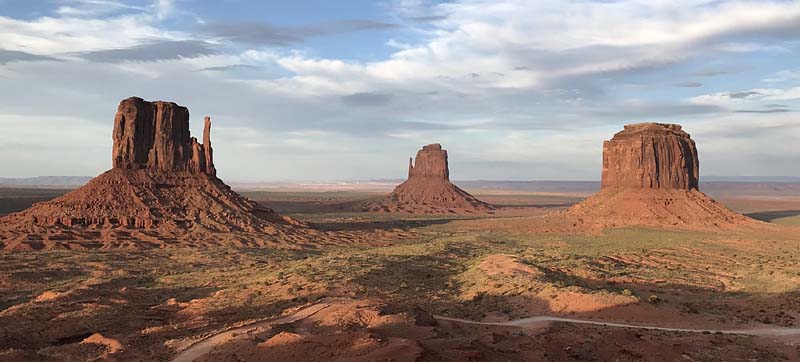
Once you enter the Monument Valley Navajo Tribal Park and drive for a short distance, your first stop should be the visitor center. Why? To gain admission and pick up a park map, so you can begin your two-hour journey via the Valley Drive. This 17-mile dirt road is a local drive-thru of Monument Valley’s finest towering formations, mesas, and buttes. On the valley road, you will see 11 numbered signposts to your right, which correspond to the most scenic sights highlighted on the park map.
The first site on the Valley Drive, beyond Lookout Point at the visitor center, has legendary native roots. The East and West Mittens, adjacent to Merrick Butte, represent spiritual beings who once inhabited Mother Earth at the beginning of time. The East Mitten rises to 1,023 feet; the West Mitten stands 978 feet. According to Navajo guides, Merrick Butte receives its name from one of two prospectors who discovered a silver lode just west of the park in the 1800s. The legend reads that a local Navajo chief named Hoskinninni and his followers killed the prospectors to keep the discovery a secret; the mine’s location is still unknown.
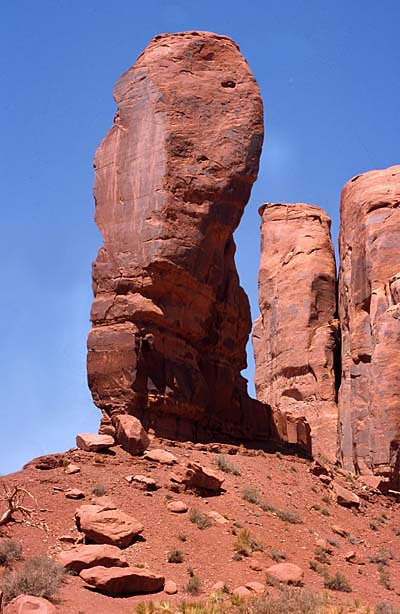 Valley Drive Sites of Famous Buttes and Mesas
Valley Drive Sites of Famous Buttes and Mesas
Elephant Butte leads off the next three sites. It is, indeed, an elephant-like formation, 778 feet high and very broad, much like its African counterpart. Next, the Three Sisters provide a stark silhouette against a blue sky. What stands out is the slimmer, shorter sister in the middle who’s escorting her two taller siblings. To the right of this formation, the fourth signpost, is John Ford Point, with Mitchell Mesa off in the distance. This is where heralded American film director John Ford staged his early western movies, including Stagecoach (1939), The Searchers (1956), and Cheyenne Autumn (1964). In fact, park officials point out that television and film producers have made John Ford Point the most famous site in Monument Valley.
The fifth signpost, Camel Butte, is easily recognizable. If you examine closely the top left-end of the butte, the formation does resemble a camel, with its hump to the right. As historians observe, John Wetherill and Harry Goulding, two early settlers and traders in the region, named many of the buttes. Of course, all of the sites within Monument Valley are sacred. One in particular, Rain God Mesa, once had four different springs, all used by area medicine men for ceremonial purposes. This general area at the sixth signpost is called The Hub because of its 153-foot wagon-wheel shape. Furthermore, it lies somewhat in the center of three mesas — Rain God, Thunderbird, and Wetherill.
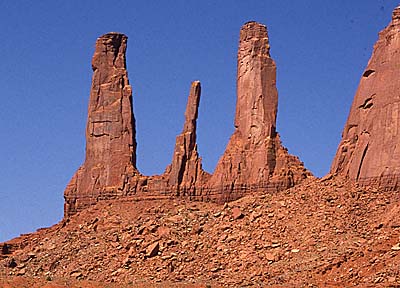 Valley Drive Sites of Navajo Ceremony and Visionary Images
Valley Drive Sites of Navajo Ceremony and Visionary Images
Adjacent to The Hub to your right are the next signposts, Totem Pole and the Yei-Bi-Chei, and then Sand Springs straight ahead. The Totem Pole is a 400-foot-high red rock formation that looks like a replica of an Indian totem pole from the Northwest, sporting pillars of carved and painted wood. Yei-Bi-Chei represents a holy figure among Navajo people. At this site, very distinguished Navajo men dress in sacred garb as Yei-Bi-Cheis and dance for healing purposes in a nine-day observance called the Night Way Ceremony. Interestingly, the rock formation appears to have a line formation of several different Yei dancers. Sand Springs, a year-round natural spring area, serves as a primary source of water for local livestock. Perhaps, it is the only site on the Valley Drive where visitors may see local Navajo residents away from their properties.
The ninth signpost, Artist Point, has an appropriate name, as it attracts photographers and artists alike. To its right sits Spearhead Mesa with Cly Butte to the left. The butte, which rises to nearly 600 feet, gets its name from a late Navajo resident, buried at the base of the mesa. The site at the 10th signpost, the North Window, is actually more of an image. As you focus your attention between Elephant Butte and Cly Butte, you envision a window frame, which is how the site acquires its name. The final signpost and scenic rock formation on the Valley Drive, The Thumb, is simply that, a well-defined upward-pointing thumb.
Red State Travel expresses appreciation to the Monument Valley Navajo Tribal Park for providing site information about the Valley Drive.
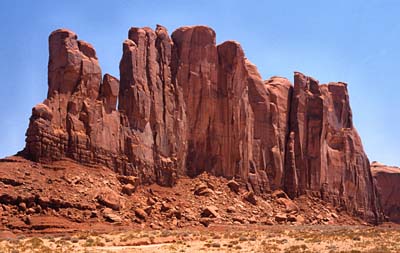 Added Amenities for Tourists in Monument Valley
Added Amenities for Tourists in Monument Valley
In addition to the Valley Drive experience, Monument Valley affords other attractive options regarding overnight or extended stays. On the rim of the valley, just south of the visitor center is an evolving amenity — The View Campgrounds. Formally known as Mitten View Campground, which hosted primitive/tent campers and recreational vehicles, the facility now also features The View Hotel and a wide array of premium cabins. Standard market rates apply to these latter accommodations, while primitive/tent campers can stay for just $10 per night; RV enthusiasts can stay for $40 per night.
The campground sites include tables, grills, trash barrels, restrooms, and showers. The View Hotel operates a more luxurious environment, highlighted by The View Restaurant. It offers breakfast, lunch, and dinner from a complete menu of Navajo-inspired dishes and classic American cuisine. Adjacent to the restaurant is The View Express, which offers deli sandwiches, hot-and-cold food to go, and cold drinks and ice cream.
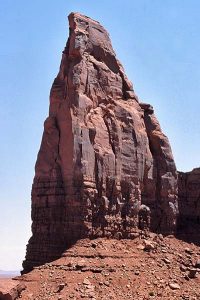 General Admission and Backcountry Permits
General Admission and Backcountry Permits
Monument Valley Navajo Tribal Park has generous hours of operation, closed only on Thanksgiving, Christmas, and New Year’s Day. During peak season (April 1 to September 30), the park is open from 6:00 a.m. to 8:00 p.m.; off-season (October 1 to March 30) hours are from 8:00 a.m. to 5:00 p.m. The admission per vehicle (noncommercial) up to four people is $20; additional passengers are $6 each. An individual pass (walk-in, bicycle, or motorcycle) is $10. Commercial passes based on vehicle capacity are also available. They start at $35 for one to four passengers and range up to $300 for more than 25 passengers. Please note that all admission fees are subject to change from the writing of this post.
Backcountry permits are necessary for hiking and camping on designated trails and campgrounds throughout the Navajo Nation. In addition to the general admission cost, a backcountry permit costs $12 per person per day. These permits are rewarding to those desiring more isolated wonders such as Anasazi dwellings, natural arches, pictographs, and petroglyphs. Keep in mind, though, for hiker safety and the protection of natural and cultural resources, the Navajo Nation Parks and Recreation Department implements backcountry guidelines.
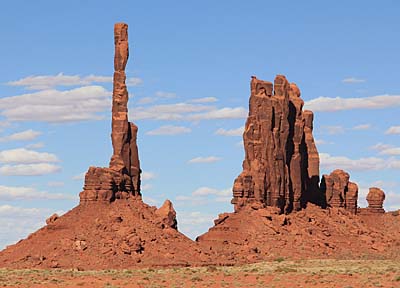 Navajo Tribal Park Etiquette
Navajo Tribal Park Etiquette
As a friendly reminder to tourists, all sites within the Navajo Nation are closed to non-Navajos unless a delegated tribal park authority issues you a valid pass or permit. Note that it is considered trespassing on a Federal Indian Reservation if you don’t have a permit. Although the following list is not all inclusive, you should always avoid these activities in Monument Valley:
- Avoid rock climbing on Navajo lands, particularly the monuments.
- Use of drones in all Navajo tribal parks is prohibited.
- Do not desecrate Navajo lands and violate the trust of the Navajo people by discarding cremated human remains.
- Use and consumption of alcoholic beverages should be avoided.
Finally, respect the privacy and customs of the Navajo people. And enter their residences only upon invitation. Photography for personal use is O.K. However, photographing Navajo residents and their properties requires their permission, and you should offer a gratuity.
For further information regarding other scenic destinations in Arizona, Utah, and the Southwest, visit here.